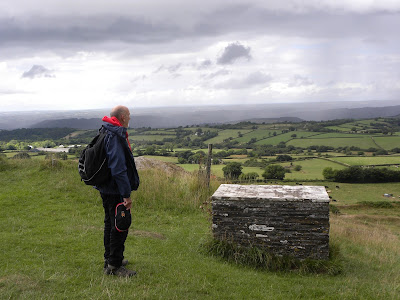As may have been guessed we've been off out with the campervan. We went back to the same campsite at Lydford but for two nights this time. Because Patch really needs feeding four times a day as well as his medicine we booked them into a local cattery. This was a very nice place and any worries were dispelled by the sight of a block of pens for a reputable local animal charity. I did have a quick look as we drove past those pens but we are not in the position to rehouse any more cats. The cats had a big pen with an upstairs sleeping area and apparently Speedy kept out of sight for a lot of the time. I took along their beds, cardboard boxes and old towels which looked a bit scruffy compared to the soft fleece beds they were also provided with. Right now Patch is asleep on my lap and Speedy is sitting on the windowsill.
Enough about the cats and on with the trip. We drove down on the Wednesday and carried on past Lydford and the village of Brentor to the 900 year old church of St. Michael on top of a lava outcrop left behind when the softer sandy rocks of the shallow sea that was there 300 million years ago had been eroded away.
There was a convenient car park that led out to the path up the wild looking hill. For me there is something very special in wild areas with the underlying rock showing through. Perhaps that has something to do with being brought up on the moors around St Ives.
The rugged path led up the tor and at every turn there were magnificent views across the surrounding countryside. There was also the homely country smell of the cows that grazed on the tor and land below.
There were many opportunities to scramble straight up the tor but we took the gentler vehicle track that wound its way up the slope.
The church is still a working church and there were a few family graves in the limited space outside.
Ropes for the bells in the 600 year old bell tower.
There was a welcoming atmosphere in the tiny church and even a tub of sweets for any visiting children. The marble plaque on the right hand wall (above) was to commemorate a local chap who died in Mesopotamia in 1916 aged 20. Another plaque commemorated a master mariner in the merchant navy who was married in the church in July and died five months later when his ship was sunk in 1939.
Standing on top of the tor it was easy to see why it may have been a beacon point and iron age fortification. (Below) The high ground on the right is Dartmoor itself. We've yet to get out onto the moor proper due to the changing weather.
I think these ridges are part of the iron age (150BC -50 AD) fortifications. This site has a lot of information about the history and geography of the place.
Looking northwards we could make out the hillside of darker trees (middle of photo below) that marked the side of Lydford Gorge which is the deepest gorge in the south-west.
We sat outside the church to eat our sandwiches and enjoy the view though I personally would prefer to see only wilderness with perhaps a few Neolithic remains. A romantic fantasy. With all the grey clouds looming we were lucky only to be caught briefly by a shower as we made our way down the path back to the car park. The showers continued on into the evening which made us appreciate how easy it is to 'set up house' when in a camper plugged into the site's power supply compared to being in a tent in a random field. We were lucky to be in the same spot as we'd had before which gave us a good view of the moor which most of the caravan/motorhome spaces didn't have.
By Thursday the rain had eased off and we had a marvellous walk, (photos tomorrow) only 3 1/2 miles but challenging, down in the gorge and in the evening we treated ourselves to a meal at the Castle Inn. This morning heavy rain had set in once again ruling out a walk on the moor so we drove home via Hatherleigh and Torrington.

















3 comments:
Thank you, Ruta, for the lovely photos and history lesson!
Wow that looks like a great place to visit. The age of things always amaze me!!!
I'm fascinated by very early history and am going to try and visit more of the many Neolithic sites that still exist.
Post a Comment